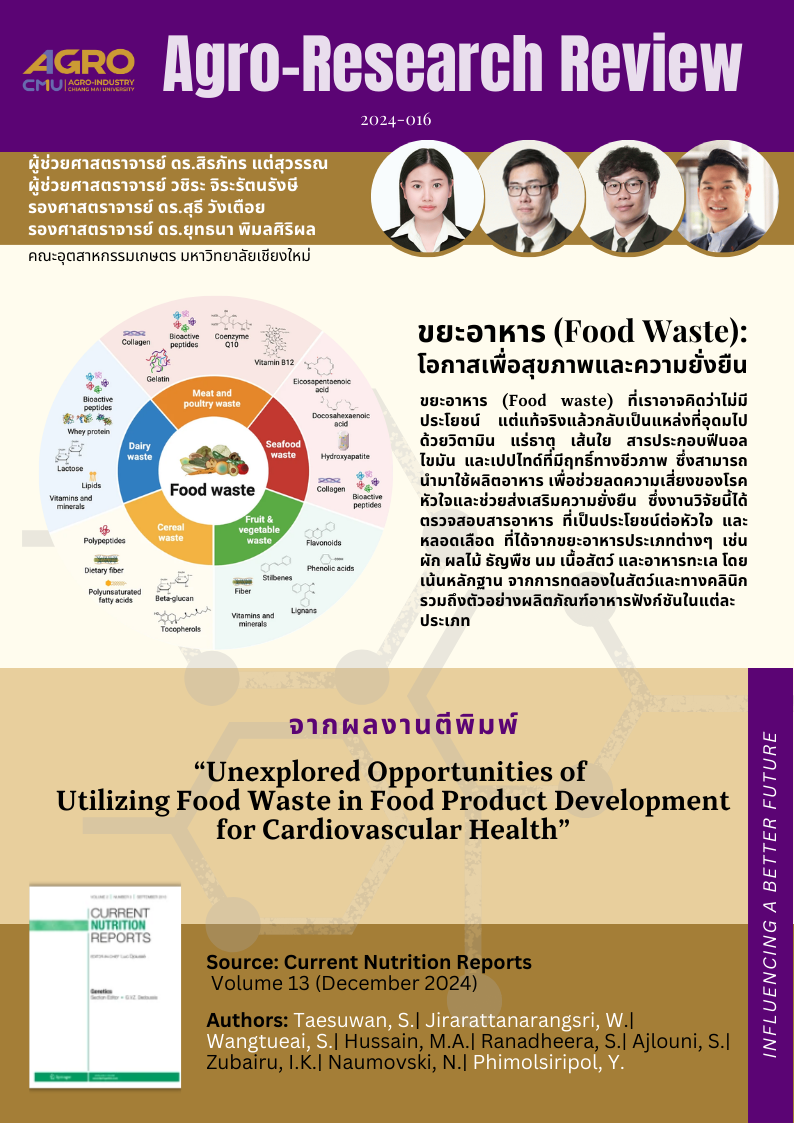
แนะนำงานวิจัย 2024-016 ขยะอาหาร (Food Waste) โอกาสเพื่อสุขภาพและความยั่งยืน
ขยะอาหาร (Food waste) ที่เราอาจคิดว่าไม่มีประโยชน์ แต่แท้จริงแล้วกลับเป็นแหล่งที่อุดมไปด้วยวิตามิน แร่ธาตุ เส้นใย สารประกอบฟีนอล ไขมัน และเปปไทด์ที่มีฤทธิ์ทางชีวภาพ ซึ่งสามารถนำมาใช้ผลิตอาหารเพื่อช่วยลดความเสี่ยงของโรคหัวใจและช่วยส่งเสริมความยั่งยืน ซึ่งงานวิจัยนี้ได้ตรวจสอบสารอาหารที่เป็นประโยชน์ต่อหัวใจและหลอดเลือด ที่ได้จากขยะอาหารประเภทต่างๆ เช่น ผัก ผลไม้ ธัญพืช นม เนื้อสัตว์ และอาหารทะเล โดยเน้นหลักฐานจากการทดลองในสัตว์และทางคลินิก รวมถึงตัวอย่างผลิตภัณฑ์อาหารฟังก์ชันในแต่ละประเภท
Food waste, which we might think of as useless, is actually a rich source of vitamins, minerals, fibers, phenolic compounds, lipids, and bioactive peptides. These components can be utilized to produce food products that help reduce the risk of heart disease and promote sustainability. This research investigates the cardiovascular benefits of nutrients derived from various types of food waste, such as vegetables, fruits, cereals, dairy, meat, and seafood. It focuses on evidence from animal and clinical studies, as well as examples of functional food products in each category.
Topic: Unexplored Opportunities of Utilizing Food Waste in Food Product Development for Cardiovascular Health
Authors: Taesuwan, S.| Jirarattanarangsri, W.| Wangtueai, S.| Hussain, M.A.| Ranadheera, S.| Ajlouni, S.| Zubairu, I.K.| Naumovski, N.| Phimolsiripol, Y.
Abstract:
Purpose of Review: Global food production leads to substantial amounts of agricultural and food waste that contribute to climate change and hinder international efforts to end food insecurity and poverty. Food waste is a rich source of vitamins, minerals, fibers, phenolic compounds, lipids, and bioactive peptides. These compounds can be used to create food products that help reduce heart disease risk and promote sustainability. This review examines the potential cardiovascular benefits of nutrients found in different food waste categories (such as fruits and vegetables, cereal, dairy, meat and poultry, and seafood), focusing on animal and clinical evidence, and giving examples of functional food products in each category. Recent Findings: Current evidence suggests that consuming fruit and vegetable pomace, cereal bran, and whey protein may lower the risk of cardiovascular disease, particularly in individuals who are at risk. This is due to improved lipid profile, reduced blood pressure and increased flow-mediated dilation, enhanced glucose and insulin regulation, decreased inflammation, as well as reduced platelet aggregation and improved endothelial function. However, the intervention studies are limited, including a low number of participants and of short duration. Summary: Food waste has great potential to be utilized as cardioprotective products. Longer-term intervention studies are necessary to substantiate the health claims of food by-products. Technological advances are needed to improve the stability and bioavailability of bioactive compounds. Implementing safety assessments and regulatory frameworks for functional food derived from food waste is crucial. This is essential for maximizing the potential of food waste, reducing carbon footprint, and improving human health.
Keywords: Cardiovascular disease; Food by-product; Food waste; valorization; Health; Nutrition; Sustainability
View at publisher: https://link.springer.com/article/10.1007/s13668-024-00571-7
#อกมช. #agrocmu #CMU






